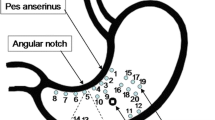Abstract
Gastric electrical stimulation (GES) was shown to improve symptoms in patients with gastroparesis. However, the underlying mechanisms remain unclear. This study assessed the influence of various patterns of GES on fasting and postprandial gastric acid secretion and 24-hr gastric pH. Eight healthy dogs were studied and we found that in the fasting state, low-frequency, long-pulse (6/12-cpm, 375-msec, 4-mA) GES at the proximal stomach significantly inhibited the secretion of gastric juice (P < 0.05). No such effect was observed during GES (6/12 cpm) at the distal stomach. In the postprandial period, low-frequency, long-pulse GES at both proximal and distal sites and at both frequencies did not significantly affect gastric acid secretion. High-frequency, short-pulse GES, investigated for obesity (21 Hz, 8 mA, and 250 μsec, with 2 secs on, 3 sec off), at the proximal and distal stomach did not significantly affect the 24-hr gastric pH profile. In conclusion, GES with various stimulation parameters, and at various sites, has little effect on gastric acid secretion. The clinical effects induced by GES at these parameters may not be related to their effect on gastric acid homeostasis.
Similar content being viewed by others
REFERENCES
McCallum RW, Chen JD, Lin ZY, Schirmer BD, Williams RD, Ross RA: Gastric pacing improves emptying and symptoms in patients with gastroparesis. Gastroenterology 114:456–461, 1998
The GEMS Study Group: Long-term results of gastric stimulation four times higher than the slow wave frequency in patients with drug-refractory gastroparesis. Gastroenterology 116:G4131, 1999 (abstr)
Abell TL, Hocking M, McCallum RW, et al.: Gastric electrical stimulation for gastroparesis: a multicenter double blind cross over study. Gastroenterology188:A2060, 2000 (abstr)
McCallum R, Sarosiek I, Lin ZY, Forster J, Abell T, Gann L, Starkebaum W: Results of long-term gastric electrical stimulation for treatment of gastroparesis refractory to standard medical therapy. Gastroenterology122:672, 2002
Mintchev MP, Bowes KL: Production of propagated antral contractions by electrical stimulation. Dig Dis Sci 41:1890, 1996
Bellahsene BE, Lind CD, Schirmer BD, Updike OL, McCallum RW: Acceleration of gastric emptying with electrical stimulation in a canine model of gastroparesis. Am J Physiol 262:G826–G834, 1992
Eagon JC, Kelly KA: Effects of gastric pacing on canine gastric motility and emptying. Am J Physiol 93:G767–G774, 1993
Xing JH, Brody F, Brodsky J, Rosen M, Ponsky J, Soffer E: Forward or reverse pacing do not affect gastric emptying of liquid meal in dogs. Gastroenterology 120:A1484, 2001
D'Argent J: Gastric electrical stimulation as therapy of morbid obesity: preliminary results from the French study. Obes Surg 12:21–25S, 2002
Delaney BC, Innes MA, Deeks J, et al.: Initial management strategies for dyspepsia. Cochrane Database Syst Rev 3:CD001961, 2001
Talley NJ, Verlinden M, Jones M. Can symptoms discriminate among those with delayed or normal gastric emptying in dysmotilitylike dyspepsia? Am J Gastroenterol 96:1422–1428, 2001
Cigaina VV, Pinato G, Rigo VV, et al.: Gastric peristalsis control by mono situ electrical stimulation: a preliminary study. Obes Surg 6:247–249, 1996
Dubois A, Natelson BH, van Eerdewegh P, Gardner JD: Gastric emptying and secretion in the rhesus monkey. Am J Physiol 232:E186–E192, 1977
Dubois A, Mizrahi M: New PC-based program to calculate gastric secretion and emptying using a marker dilution technique. Dig Dis Sci 37:1302–1303, 1992
Bodger K, Daly MJ, Heatley RV: Prescribing patterns for dyspepsia in primary care: a prospective study of selected general practitioners. Aliment Pharmacol Ther 10:889–895, 1996
Valle JD, Todisco A: Gastric secretion. In The Textbook of Gastroenterology, 3rd ed. T Yamada (ed). Philadelphia, 1999, pp 278–319, Lippincott.
Wang ZS, Xu XH, Ueno T, Chen JD: Effects and mechanisms of forward and backward gastric electrical stimulation with pulse trains. Gastroenterology 120:2348, 2001.
Meulemans AL, Eelen JG, Schuurkes JA: NO mediates gastric relaxation after brief vagal stimulation in anesthetized dogs. Am J Physiol 269:G255–G261, 1995
Kato S, Kitamura M, Korolkiewicz RP, Takeuchi K: Role of nitric oxide in regulation of gastric acid secretion in rats: effects of NO donors and NO synthase inhibitor. Br J Pharmacol 123:839–846, 1998
Bilski J, Konturek PC, Konturek SJ, Cieszkowski M, Czarnobilski K: Role of endogenous nitric oxide in the control of gastric acid secretion, blood flow and gastrin release in conscious dogs. Regul Pept 53:175–184, 1994
Molero M, Hernandez IM, Lobo P, Cardenas P, Romero R, Chacin J: Modulation by nitric oxide of gastric acid secretion in toads. Acta Physiol Scand 164:229–236, 1998
Berg A, Kechagias S, Sjostrand SE, Ericson AC: Morphological support for paracrine inhibition of gastric acid secretion by nitric oxide in humans. Scand J Gastroenterol 36:1016–1021, 2001
Tack J, Coulie B, Van Custem E, Ryden J, Jassens J: The influence of gastric electrical stimulation on proximal gastric motor and sensory function in severe idiopathic gastroparesis. Gastroenterology 116:G4733, 1999 (abstr)
Xing JH, Brody F, Ponsky J, Larive B, Soffer E: Forward, but not reverse pacing affects gastric tone in dogs. Gastroenterology 120:A518, 2001
Author information
Authors and Affiliations
Rights and permissions
About this article
Cite this article
Xing, JH., Rosen, M., Brody, F. et al. Gastric Electrical Stimulation Does Not Significantly Affect Canine Gastric Acid Secretion and 24-Hour Gastric pH. Dig Dis Sci 49, 48–53 (2004). https://doi.org/10.1023/B:DDAS.0000011601.17400.78
Issue Date:
DOI: https://doi.org/10.1023/B:DDAS.0000011601.17400.78




